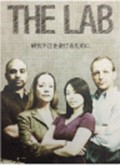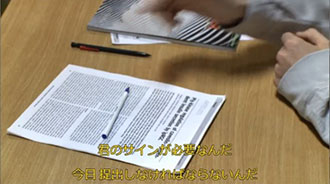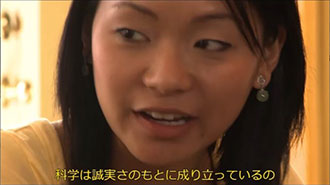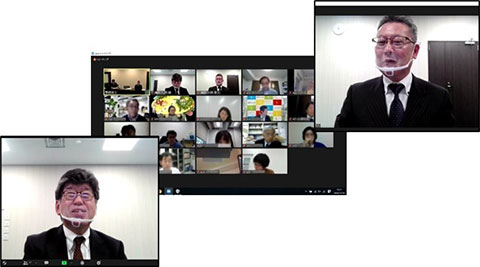Event Reports
The 6th JST Workshop "Promoting Activities toward Research Integrity - How to Practice Effective Research Ethics Education" Report (10 Dec '20, 18 Dec '20)
The Japan Science and Technology Agency (JST) holds the JST Workshop on "Promoting Activities toward Research Integrity" every year. The purpose of this workshop is to learn how to promote activities toward research integrity through pre-works, lectures, and group works. The 6th workshop (WS) in the series was held online on 10 December and 18 December, 2022.

The theme of this time is "Considering How to Practice Effective Research Ethics Education." It was aimed at experienced researchers in charge of research ethics education at universities and research institutes (more than three-year experience of overseeing practical work). It was a fruitful workshop using THE LAB1 as practical teaching materials, aiming to set learning and educational objectives, design educational plans, and acquire educational implementation and evaluation, together with the aim of bringing back the results of the workshop to participants' own institutions as the hints for practicing research ethics education.
Here is the outline of the day.
1 THE LAB: It is an interactive video material that allows viewers to learn about research integrity while making decisions about ethical issues they face through various roles (created by the Office of Research Integrity). In the WS, participants mainly experienced the role of graduate student, Kim.
1. Learning and educational objectives and its methods
1-1. Lecture on "Learning and Educational Objectives and its Methods" (Prof. Jun Fudano)
First, Prof. Fudano of Waseda University gave a lecture on learning and educational objectives and its methods of research ethics education.
Prof. Fudano expressed an idea that research ethics education should be clearly defined learning and educational objectives and conducted based on that. The following three categories of learning and educational objectives were also presented: Knowledge and Understanding, Abilities and Skills, and Values and Attitudes.
- Related "Knowledge and Understanding" needed to make appropriate decisions in situations where ethical judgment is required.
- "Abilities and Skills" to properly analyze and judge situations.
- "Values and Attitudes" of each person that have a fundamental influence on ethical judgment and decision-making.
The actual contents of research ethics education are diverse. Prof. Fudano used a table of contents in the textbook "For the Sound Development of Science -The Attitude of a Conscientious Scientist-" created by the Japan Society for the Promotion of Science as an example to illustrate some of the contents of research ethics education.
He also explained what kind of educational methods are available according to each learning and educational objectives based on an example of a practical class module (learning and educational objectives for building courses, components, things that presents practical methods and its order, and author's notes) created by the Academic Research Ethical Review Committee of the Japanese Society for Engineering Education.
Furthermore, he suggested the importance of education on "Values and Attitudes," and that it would be effective to introduce the concept of "oriented ethics" as well as "preventive ethics" to prevent existing misconducts in the formation of "values and attitudes."
1-2. Practice based on THE LAB (experience of educational example)
After Prof. Fudano's lecture, specific educational methods using THE LAB was introduced. Each category of learning and educational objectives was introduced, and participants experienced the discussion about one of them.
Practice 1: Knowledge and Understanding -- Learning and Educational Objectives "Understanding the Meaning and Importance of Authorship"

- THE LAB (part of graduate student Kim): Watch the scene where Kim is asked for autograph as a co-author
- Lecture on the authorship by lecturer using the Uniform Requirements of the International Committee of Medical Journal Editors (ICMJE)
- Individual examination
-
Group discussion in groups of three or four people
Theme:
- Whether Kim can be a co-author in the first place
- How should the order of co-authors be determined
*There was a comment from the lecturer about the desire to take enough time and make an authorship policy for each laboratory in actual classes, if possible.
Practice 2: Abilities and Skills -- Learning and Educational Objectives "Ethical Decision Making"
Process of the class- Video material: Watch the same part as Practice 1.
- Explanation of ethical decision making by lecturer using the Seven Step Method2
- After the individual examination, move on to group discussion
2 The Seven Step Method is an ethical decision-making framework developed by Prof. Michael Davis of Illinois Institute of Technology.
Practice 3: Values and Attitudes -- Learning and Educational Objectives "Responsibilities of Researchers and Their Social Roles"

- Video material THE LAB: (Part of Aaron, the Principal Investigator) Watch a scene where he talks with his wife while working at home at night
- Lectures on the responsibilities and social roles of researchers using the Science Council of Japan's Formulation of Code of Conduct for Scientists3 and Hong Kong Principles for Assessing Researchers.4
- Individual examination and group discussion
3 Formulation of Code of Conduct for Scientists in January 2013 (Science Council of Japan's website)
4 Hong Kong Principles for Assessing Researchers is principals for assessing researchers which were established and approved at the 6th World Conference on Research Integrity (WCRI) in June 2019.
1-3. Group work 1: Select subjects, learning and educational objectives, and materials to be used
After the introduction of educational methods, in Group Work (GW) 1, an educational plan was made using teaching materials so that participants can actually conduct research ethics education at their own institution. The participants watched THE LAB beforehand and chose the scenes in it, which are suitable for research ethics education to solve their own problems. Participants were divided into groups of three or four and discussed the following based on their own organization's challenges (problems they have):
1-1: Setting subjects for education
1-2: Setting learning and educational objectives
1-3: Scenes in THE LAB that will be used as a teaching material to achieve the learning and educational objectives
After the discussion, each group made a presentation.
One group set the subjects for education as doctoral students and young researchers and set the objective as acquisition of skills to solve ethical problems, acquisition of knowledge about reporting and investigation methods of research misconduct, and acquisition of knowledge about rules and policies related to research misconduct. And the group announced that they would use the scene where Kim, who was suspicious of data tampering, was wondering who to talk to, as for the scene of THE LAB to use.
Some groups chose the scene as a teaching material where Kim, who had doubts about his thesis, was talking to his mother.
 The group set master's student as the subject for education and set their objective as to have a belief as a researcher who can publish fair research to the society. They chose two scenes where Kim was asked to sign as a co-author for proofreading his thesis, and a scene where Kim explained integrity in science to his mother who recommended not to do anything.
The group set master's student as the subject for education and set their objective as to have a belief as a researcher who can publish fair research to the society. They chose two scenes where Kim was asked to sign as a co-author for proofreading his thesis, and a scene where Kim explained integrity in science to his mother who recommended not to do anything.
2. Evaluation and Design
2-1. Lecture: Evaluation and Design of Ethics Education -- Considering Educational Setting by Setting Objectives and Evaluation of Ethics Education" (Prof. Yukito Kobayashi)
In GW2, based on the learning and educational objectives set in GW1, comprehensive research ethics education was designed that incorporates the perspective of evaluation.
First, Prof. Kobayashi of Kumamoto National Institute of Technology, Kumamoto College gave a lecture on evaluation and design of research ethics education.
At the beginning of the lecture, he explained that the purpose of this workshop (GW2) is to grasp the "evaluation" of research ethics education as an educational effect rather than an evaluation of grades, and to examine it from the perspective of improving educational methods.
Prof. Kobayashi also explained that learning and educational objectives are divided into Goal, Objective, and Target levels according to their size and duration. In this WS, participants were asked to narrow down their learning and educational, and to reflect their expected target actions (that can be expected through one-frame classes and lectures).
He also emphasized that setting objectives should be considered in conjunction with setting evaluation methods and defining learning activities. This is because the evaluation criteria and methods will change according to learning and educational objectives, and the learning activities of the subject for education and the educational methods by the lecturers will also change.5
Knowing each other's criteria for "evaluation," lecturers and subjects can share a concrete image of the objectives, and they can also share and promote actions (learning activities) to achieve them.
The lecture provided advice on setting objective and evaluation for each category: Knowledge and Understanding, Abilities and Skills, and Values and Attitudes.
- The evaluation criteria and methods for the learning and educational objectives set in GW1 and the level of achievement should be considered in an integrated manner.
- Evaluation criteria and methods should be applied and then expressed in terms of behavioral characteristics, such as "what specific actions are expected to be taken."
- Learning activities and educational methods should be considered as necessary for achieving the above learning and educational objectives.
5 "For example, when just doing a paper test that can be handled by memorization, learners are guided into a learning activity of memorization, and their objective becomes to act from just memory and recollection. If research is evaluated only by the number of theses and if indicators, it can be a hotbed of misconducts." Prof. Kobayashi
2-2. Group work 2: Reviewing educational and evaluation methods
GW2 spent 90 minutes to fully complete. In the same group as GW1, we reviewed the following in order to achieve the learning and teaching objectives set by each group.
2-1: Criteria and methods for measuring and evaluating the achievement of learning and educational objectives
2-2: Learning activities and educational methods (educational intervention)
2-3: Notes
In GW2, each group gave a presentation after the discussion.
One group set two objectives: 1. Understand the social responsibility and significance required for researchers. 2. Make appropriate decisions when faced with ethical issues. The criteria for assessing achievement level of such objectives were set as following: 1. Being able to increase the significance of their own research results and research process and list the impact of conducting inappropriate research. 2. Being able to prepare negative options and make more fair judgments to the society regardless of which option is chosen. In the review of methods for learning activities and education, it was decided to use methods such as lectures and group work that share cases of misconducts and proposed to make learners think about bad scenarios and recognize their own attitudes.
Each group presented a variety of learning and educational objectives, measurement and evaluation criteria, and methods. All content was carefully thought out. Based on many learning and educational objectives, methods of measurement and evaluation, and candidates for learning activities, it was apparent that in-depth consideration was conducted within each group.
Throughout the presentations in GW2, many groups set objectives that belong to "Values and Attitudes," such as whether they are currently conducting research activities in a responsible manner and considered methods to measure learning achievements based on the objectives as the evaluation criteria.
3. Comments and opinion
After the presentation, both lecturers gave comments.
Prof. Fudano commented the importance of aspirational ethics once again, saying that the idea fundamentally supporting knowledge and skills is the ethics (values) as a researcher; "What am I doing research for?"
Prof. Kobayashi also commented that most of the groups set objectives that belongs to Values and Attitudes in their presentations after the GW2, while mentioning that "Values and Attitudes" are the foundation of education and they could have in-depth discussion.
Lastly, Prof. Fudano said, "it was my first online WS, but there were advantages of doing them online such as the convenience of sharing materials immediately, and we were able to have high-quality discussions that surpassed face-to-face discussions. I would like everyone to utilize the knowledge you have gained from this WS in the future." The day-long workshop was concluded.
We have received the following comments from participants.
"Having created deliverables through the GW and shared them with all the members, I think I can utilize what I have learned."
"It helped me to gain useful knowledge and information for the design and implementation of education."
"Some of the efforts in other organizations were informative."
"I really sympathized with the installation of aspirational research ethics education.", etc.
JST will continue to hold events that contribute to research integrity in the future, so please look forward to them.


